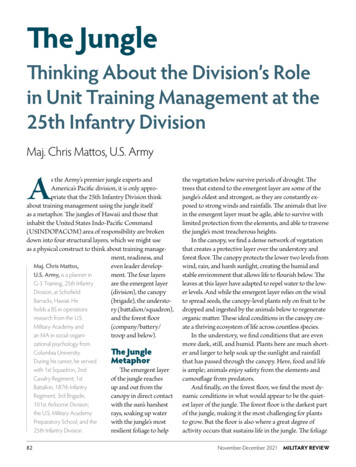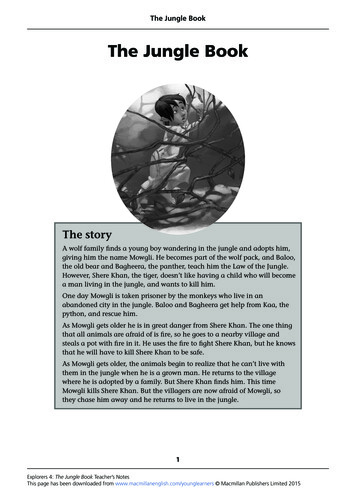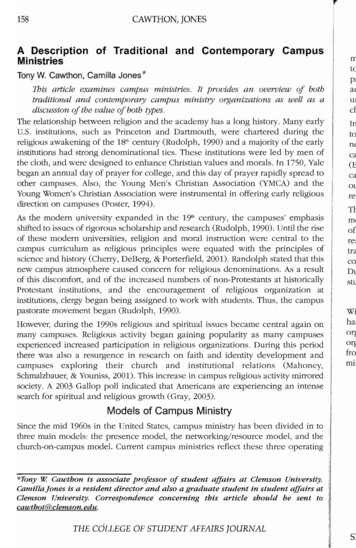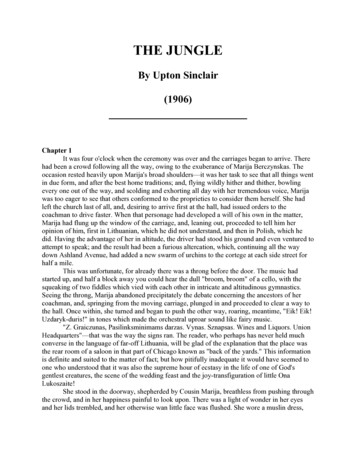
Transcription
The JungleThinking About the Division’s Rolein Unit Training Management at the25th Infantry DivisionMaj. Chris Mattos, U.S. ArmyAs the Army’s premier jungle experts andAmerica’s Pacific division, it is only appropriate that the 25th Infantry Division thinkabout training management using the jungle itselfas a metaphor. The jungles of Hawaii and those thatinhabit the United States Indo-Pacific Command(USINDOPACOM) area of responsibility are brokendown into four structural layers, which we might useas a physical construct to think about training management, readiness, andMaj. Chris Mattos,even leader developU.S. Army, is a planner inment. The four layersG-3 Training, 25th Infantryare the emergent layerDivision, at Schofield(division), the canopyBarracks, Hawaii. He(brigade), the understoholds a BS in operationsry (battalion/squadron),research from the U.S.and the forest floorMilitary Academy and(company/battery/an MA in social-organitroop and below).zational psychology fromColumbia University.During his career, he servedwith 1st Squadron, 2ndCavalry Regiment; 1stBattalion, 187th InfantryRegiment, 3rd Brigade,101st Airborne Division;the U.S. Military AcademyPreparatory School; and the25th Infantry Division.82The JungleMetaphorThe emergent layerof the jungle reachesup and out from thecanopy in direct contactwith the sun’s harshestrays, soaking up waterwith the jungle’s mostresilient foliage to helpthe vegetation below survive periods of drought. Thetrees that extend to the emergent layer are some of thejungle’s oldest and strongest, as they are constantly exposed to strong winds and rainfalls. The animals that livein the emergent layer must be agile, able to survive withlimited protection from the elements, and able to traversethe jungle’s most treacherous heights.In the canopy, we find a dense network of vegetationthat creates a protective layer over the understory andforest floor. The canopy protects the lower two levels fromwind, rain, and harsh sunlight, creating the humid andstable environment that allows life to flourish below. Theleaves at this layer have adapted to repel water to the lower levels. And while the emergent layer relies on the windto spread seeds, the canopy-level plants rely on fruit to bedropped and ingested by the animals below to regenerateorganic matter. These ideal conditions in the canopy create a thriving ecosystem of life across countless species.In the understory, we find conditions that are evenmore dark, still, and humid. Plants here are much shorter and larger to help soak up the sunlight and rainfallthat has passed through the canopy. Here, food and lifeis ample; animals enjoy safety from the elements andcamouflage from predators.And finally, on the forest floor, we find the most dynamic conditions in what would appear to be the quietest layer of the jungle. The forest floor is the darkest partof the jungle, making it the most challenging for plantsto grow. But the floor is also where a great degree ofactivity occurs that sustains life in the jungle. The foliageNovember-December 2021MILITARY REVIEW
Soldiers from 1st Battalion, 21st Infantry Regiment (Gimlets), 2nd Infantry Brigade Combat Team, 25th Infantry Division, conduct company evaluations in movement to contact, attack, and defense operations 13 March 2020 during deployment to Kahuku Training Area, Schofield Barracks,Oahu, Hawaii. (Photo by Photo by Pfc. Jessica Scott, U.S. Army)that falls to floor decomposes and regenerates to providenutrients to the rest of the jungle. Countless species relyon the regenerative processes that occur here to surviveand thrive. Here we see a vast network of interconnected root systems that allows the many plant and fungispecies to communicate, adapt to changing conditions,and share resources in a massive symbiotic symphony ofregeneration and growth.Unit Training ManagementThe term “unit training management” (UTM) is auniversal part of the U.S. Army lexicon. And althoughthe term is frequently used and generally understood,what exactly is training management? For the purposes of this article, what exactly do we mean when wetalk about training management at the division level?Although the discrete components are explained indetail, anyone would be hard-pressed to find a conciseMILITARY REVIEWNovember-December 2021Army definition of the term in any of the current orformer 7-0 series doctrine. The Leader’s Guide to UnitTraining Management, published by the CombinedArms Center in December 2013, defines UTM as “theprocess commanders, leaders and staffs use to plan unittraining and identify the resources needed to plan-prepare-execute-assess training.”1At brigade and below levels, UTM is most oftendescribed through its primary component systemsand processes: the 8-step training model, the T-weekconstruct, unit training plan development, etc. UTMis also described as a parallel planning process thataligns with troop-leading procedures at company andbelow levels, and the military decision-making process at battalion and above levels. Further, UTM isoften, and should be, described as an interconnectedsystem that aligns with both the “plan-prepare-execute-assess” operations framework as well as the83
A soldier rappels from a UH-60 Black Hawk helicopter 22 April 2021during a ten-day air assault course at the 25th Infantry Division Lightning Academy at Schofield Barracks, Hawaii. In addition to rappelling,students learned about sling loading operations and aircraft operations during the course. (Photo by Spc. Jessica Scott, U.S. Army)
THE JUNGLEcommander’s activities in the operations ad-assess.”Thinking About TrainingManagement at the Division LevelWhile this largely scientific approach to understanding UTM is critical and serves our brigade and belowechelons well, we must ask if this approach is applicableat the division level. Like the emergent layer of the jungle,we might think about the division’s role in UTM as morethan just the managers of another planning process.The division headquarters, including the commandteam and the staff, has a significant responsibility to shapethe training environment for the “canopy” below. The division exercises several critical duties in this model. First,the division shapes the training environment that createsthe conditions for mission-essential task proficiencygrowth and the overall growth of training readiness. Thedivision is the conduit between the executors of trainingand the operational environment, which includes higherheadquarters’ (HHQ) guidance and intent, the physicalterrain, the enemy, the information domain, and resources availability, which may include land, ammo, money,facilities, transportation, fuel, and most importantly, time.As it would in a tactical operation, the division performs as the shaping mission command node, providingguidance and intent, controlling the deep fight, definingthe battle space, providing enabling assets, managingoperational tempo (OPTEMPO), weighting efforts, andsynchronizing activities. The division leverages its wholeof-staff capacity and its relationships with both HHQsand adjacent units to create the conditions in whichUTM can be conducted efficiently. Further, the divisionis responsible for change management, finite resourceprioritization, and clearly defining and communicatingrequisite training end states in order to build and sustaintraining readiness. The division protects the lower echelons from the naturally occurring known and unknownchanges in the environment.While the division shapes the training atmospherethrough annual training guidance, policy, and long-rangesynchronization, the brigade, or the canopy layer, isfocused on multiechelon and multiformation prioritization, resourcing, and deliberate planning. The brigade fitswithin the division’s vision and guidance to provide direction and an explicit description of the desired capabilityend states for each subordinate element within each ofMILITARY REVIEWNovember-December 2021the relative event horizons that drive their unit trainingplan. Battalions, or the understory layer, take this framework and provide specific focus and direction for each ofthe company’s unique requirements. Where the brigadegenerally plans and allocates resources, the battalionprioritizes and delivers those resources, including time,to the companies. The company and below, or forest floorlayer, forecasts, requests, and consumes those allocatedresources in order to meet unit training objectives underthe direct supervision of company-level leaders.Unique TrainingManagement Dynamicsin the 25th Infantry DivisionIn the 25th Infantry Division (25th ID), thereare several unique dynamics that impact the trainingmanagement landscape. First, as one of the Army’sdivisions outside of the continental United States(CONUS), we are task organized with two infantrybrigade combat teams (IBCTs), each with two infantrybattalions and a cavalry squadron; a CONUS infantrydivision is typically organized with three IBCTs, eachwith three infantry battalions and a cavalry squadron. In addition, in the last several years, the 25th IDredesigned its two Stryker brigade combat teams to beIBCTs. With the loss of the Strykers also came changesto our security cooperation partnerships in the Pacific.Some of our primary partners were in the process offielding Stryker variants in their own armies, makingother Stryker-capable formations a more preferredpartner to those nations. When this change in thesecurity cooperation landscape occurred, the 25th ID’srole in major annual exercises like Pacific Pathwaysalso changed. These strategic-level shifts had severaldown-trace impacts on how our two-IBCT divisionscould maintain training readiness in a given fiscal year.In one training year, the 25th ID conducted a collective training exercise (CTE) called Lightning Forge thatserved as a brigade external evaluation in preparationfor an annual collective training center (CTC) rotation to the Joint Readiness Training Center (JRTC) inFort Polk, Louisiana. It also supported a several-monthrotation to the Pacific in support of Pacific Pathways inwhich a predominance of one IBCT as well as a portionof the division staff, the combat aviation brigade (CAB),the division artillery brigade, and the division supportbrigade (DSB) all deployed to multiple Pacific countries85
to conduct partnered training. This means that everyyear, one IBCT conducts three back-to-back majorevents: the CTE, the CTC rotation, and the Pathwaysrotations. This is to allow the other IBCT to build training readiness through home station collective training inpreparation for the following year, where it becomes theprimary training audience for the next iteration of thoseThe second unique dynamic derives from our command relationships to our HHQs. The 25th ID is theonly non-Forces Command (FORSCOM) division inthe Army. We have a combatant command relationshipto USINDOPACOM, we are assigned to Army Pacific(which is the Army Service Component Command toUSINDOPACOM), and we have an operational con-Not unlike many other Army training areas, but certainly more so in Hawaii, there are a multitude of environmental, cultural, and community-based considerationsthat our training planners must also account for.same three events. The CAB, division artillery brigade,and DSB continuously support these events regardlessof which IBCT is the focal unit, in addition to its routineunit training requirements like aerial gunnery, sustainment gunnery, and artillery gunnery tables. Many ofthese events occur simultaneously with Pacific Pathwaysin order to ensure the division continues to build readiness across all metrics versus atrophying during majorengagements in the Pacific.In addition to these three major events, the division also conducts expert infantryman badge training, expert soldier badge training, and expert fieldmedic badge training. It also participates in multiplejoint and multinational command post exercises andmultiple additional partnership engagements that falloutside of the Pacific Pathways umbrella. All of thisis on top of normal steady state home station trainingrequirements like mandatory Army Regulation (AR)350-1, Army Training and Leader Development, training,marksmanship qualification densities in accordancewith the integrated weapons training strategy, individual warrior skills training, collective training like situational training exercises, field training exercises, andlive-fire exercises (LFXs) at the team through battalionechelons. All the while, units are tasked to modernize, conducting multiple new equipment training andnew equipment fielding events. And if that were notenough, at all times multiple units in the division areon standby to support crisis response requirementsin the area of responsibility, which requires a host ofemergency readiness deployment exercise drills.86trol relationship to I Corps. This command relationshipdynamic is unique to the 25th ID and expands its supportrequirements to multiple stakeholders.The third dynamic unique to the 25th ID is a function of its role as the U.S. Army Hawaii command as wellas its physical geographic location. The commandinggeneral of the 25th ID simultaneously serves as the U.S.Army Hawaii commander, and he is administrativelyresponsible for multiple Army entities located in Hawaiito include U.S. Army Garrison Hawaii, the 9th MissionSupport Command, 8th Theatre Sustainment Command,18th Medical Command, 500th Military IntelligenceBrigade, 94th Air and Missile Defense, and 311th TheatreSignal Command. Further, the 25th ID also has habitualrelationships and supports external training requirementsfor adjacent units such as the Hawaii Army NationalGuard, University of Hawaii Reserve Officer TrainingCorps, Special Operations Forces, U.S. Air Force, andU.S. Marines. These relationships bring with them a hostof additional training support requirements as well asunique training opportunities.Lastly, the island itself creates unique training management challenges. Transportation to the mainland forCONUS-based training exercises like JRTC typicallyincurs several additional weeks of movement for rollingstock and equipment. This also requires utilization oflimited logistics support vessel capabilities. The relativelysmall size of Oahu as well as the high demand for limitedrange and training facilities makes land resource forecasting and allocation uniquely cumbersome. Not unlikemany other Army training areas, but certainly more so inNovember-December 2021MILITARY REVIEW
THE JUNGLEHawaii, there are a multitude of environmental, cultural,and community-based considerations that our trainingplanners must also account for. Finally, our largest training area, the Pohakuloa Training Area, resides off-islandsome two hundred kilometers across the Pacific Oceanon the “Big Island,” again increasing logistical and transportation planning factors for our brigades and battalions.Approaching TrainingManagement HurdlesThese challenges (and often opportunities) makelong-range training planning and synchronizationunique in the 25th ID. Without proper forecasting,these factors have the potential to overburden our twoIBCTs as well as the limited support capacity of thedivision artillery, CAB, and DSB. As part of the comprehensive effort to prioritize people and to increasethe overall readiness of the force, the Army is helpingdivisions achieve this predictability.In the past several decades, we have witnessed theArmy transition across several readiness models toinclude the Army force generation model, regionally aligned forces, objective training assessment, andthe sustainable readiness model. This year, the Armyhas unveiled the Regionally Aligned Readiness andModernization Model (ReARMM) as the marqueeMILITARY REVIEWNovember-December 2021Soldiers with the 25th Infantry Division conduct a river crossing June2020 during training at the Jungle School at Schofield Barracks, Hawaii.(Photo courtesy of 25th Infantry Division)readiness model that will guide the Army into the future. The model aims to synchronize training, missionrequirements, and modernization efforts while aligningforces to specific geographic combatant commands inorder to maximize readiness and predictability. Themodel will be driven by the universal implementationof the Army synchronization toolset that will serve asthe Army-level system of record to input, track, project, and synchronize training, mission, and modernization requirements across the force.At the division level, we have also begun to transform,refine, and improve our systems and processes to executethe division-level training management philosophy previously outlined and set the conditions for a transition toReARMM. The first step was defining what we wantedour two-year training model to look like for the division.Given the two-IBCT set and the multitude of requirements defined above, we created a predictable doctrinaltemplate that uniformly laid out in time and space whenmajor events should occur in order to give subordinateunits maximum planning predictability.87
Second, we developed annual direction of attackplans that pre-identified and forecasted known frictionperiods in order to allow the staff to begin shaping andmitigating risk much earlier in the planning cycle. Usingevent-based planning horizons and critical mission drivers (like command post exercises, CTEs, CTC rotations,Warfighter exercises, force modernization windows, andcrisis response missions), we were better able to accountfor recurring high-risk periods, especially centered on periods of transition. Further, it was clear that as a division,planning efforts were generally stovepiped both withinthe operations enterprise and across the staff. We implemented a routine operations synchronization event and asemiannual division-level resourcing conference aimed atsynchronizing efforts across the organization.These events have been designed to nest and feed intoroutine division-level training management processeslike our annual training guidance publication, semiannual training briefs, and training resourcing integrationconferences. In addition, they nest and feed into theArmy synchronization and resourcing process, whichmost notably includes the semiannual Army synchronization and resourcing conference and Army modernization and equipping conference. These efforts, in additionto our endeavors to reform our orders process, develop acompany-battery-troop training meeting handbook, andcreate a division digital training guide, have significantlyassisted the division in performing more as the “emergent layer” in service to the “canopy” and below layers.They have better allowed us to shape the future trainingenvironment by substantially improving predictability,prioritizing and synchronizing efforts, and allocatingprecious resources efficiently and effectively. All of thisis in the pursuit of improving the lethality of the forcethrough building and sustaining readiness.As we look to the future of the division under bothReARMM and the new “People First!” strategy, we arealso beginning to ask some hard questions about whatthe future of our JRTC rotations may look like for the25th ID.2 First and foremost, in line with the Army seniorleader’s message to the force, we are thinking about thecost benefit of sending an IBCT from the 25th ID toJRTC. Our primary mission is to conduct persistentengagement with regional partners to shape the environment and prevent conflict across the USINDOPACOMregion. Thus, we must consider the extent to which wecan build training readiness during collective training at88home station with Joint Pacific Multinational ReadinessCenter support and during Pacific Pathways. This allowsfor the potential to train and certify units in a jungleenvironment, to give us more flexibility to conduct forcemodernization, and also to significantly reduce the financial cost, equipment readiness risk, and high OPTEMPOcosts to our soldiers and families associated with conducting a JRTC rotation, CTE, and Pathways deployment in the same year (especially given the two-IBCTset). If Forces Command looks to reduce the echelonat which it focuses training at JRTC, it may be possibleto accomplish many of training objectives here in thePacific that we would otherwise accomplish at JRTC, allthe while saving a lot of time, resources, and stress on thesoldiers, families, and equipment.However, given the assumption that the 25th ID willcontinue to execute JRTC rotations as planned, there isthe potential to allow brigades to conduct platoon LFXsand company combined arms LFXs at home station,whereas LFX days at JRTC could be used as force-onforce contingency training. Field training exercises arewhere organizations build multiechelon mission command and tactical proficiency. Training proficiency (toinclude live-fire confidence) can and should be focusedon squads and platoons, culminating at most withcompany situational training exercises and companycombined arms LFXs prior to attending a CTC rotation.Battalion- and brigade-centric proficiency can be exercised and assessed using home station CTEs, virtual orconstructed mission command exercises, Pacific engagements, and mobile external evaluation (i.e., Joint PacificMultinational Readiness Center). Brigade externalevaluations do not necessarily need to be JRTC prerequisites, although that training time should still be usedto train and certify at least to the company level priorto any given JRTC rotation. In the potential absence ofa JRTC rotation, that CTE window should be used tobuild repetition at the appropriate echelon in accordancewith upcoming Pacific Pathways requirements and asnested with the annual training guidance.The last paradox we are trying to reconcile is thetension between the Army’s transition to preparing forlarge-scale combat operations (LSCO) against potential near-peer competitors and the Army’s shift towardfocusing on the company level and below lethality whileassuming risk at the battalion and above levels. In theLSCO environment, as well as in ReARMM, the divisionNovember-December 2021MILITARY REVIEW
THE JUNGLEis the central maneuver unit. Thus, it could be argued thatfrom an operational perspective, we should be focusingon brigades and divisions across all warfighting functionsand mission command competencies.Further, it could be posited under this paradigm thatdivisions should also be the central focal point as the ro-ready force capable of maintaining persistent engagement with regional partners to enable a free and openINDOPACIFIC that is prepared to rapidly deploy, fight,and win in a large scale combat operations anywhere inthe world.”4 The line of effort is divided into four sublinesof effort: (1) operational readiness, defined as “ensuringWe need to find creative ways to build and retainstrategic overmatch both in our technological capabilities and in our tactical and operational proficiencywhile simultaneously meeting the Army’s guidance tobuild readiness by truly putting our people first.tational unit at JRTC. This position, however, does notmeet the intent of the current “People First!” strategythat aims to simultaneously increase small-unit lethalitywhile decreasing OPTEMPO and reduce stress on soldiers and families. Because of this seemingly competingdynamic, as a division, it is becoming even more important that we are able to do both well. Our ability to understand this new operating and training environment,shape guidance accordingly, and synchronize activitiesin time and space has become all the more critical. Weneed to find creative ways to build and retain strategicovermatch both in our technological capabilities and inour tactical and operational proficiency while simultaneously meeting the Army’s guidance to build readinessby truly putting our people first.ReadinessDepending on the venue, reference, or discussiontopic, we all tend to think and talk about readiness invery different ways. AR 525-30, Army Strategic andOperational Readiness, defines readiness as “the abilityof U.S. military forces to fight and meet the demandsof the NMS [National Mission Strategy], with unitreadiness defined as “the ability of a unit to performas designed.”3 In the 25th ID, we think and talk aboutreadiness as an essential component of the commandinggeneral’s operational approach, which is comprised offour primary lines of effort: people, partnerships, readiness, and innovation/modernization.The readiness line of effort, “Train, Deploy, Fight,Win!,” is defined as the ability to “sustain an agile andMILITARY REVIEWNovember-December 2021assigned forces are capable of deploying regionally andworldwide with little notice”; (2) training readiness,defined as “units are trained, certified, and ready to execute their METL [mission essential task list] tasks”; (3)manning, defined as “units are sources to meet trainingand deployment readiness objectives”; and (4) equipment readiness, defined as our “equipment, property,supply stocks, and management processes enable units tomaintain constant operational readiness.”5 The ultimateend state of this line of effort is that every “light fighter”in the 25th ID is physically fit, mentally tough, and highlytrained as jungle operations experts to deploy, fight, andwin in LSCO anywhere in the world. This frameworkhas served as an essential primer to assist the division inthinking about readiness, but it is also clear that thesedefinitions do not completely encapsulate the intangibleessence of readiness that we also aim to improve upon.We believe that readiness is more than just projected PSRT ratings.6 Although these projections mayserve as reliable indicators of readiness, true readinessresides in our organization’s ability to perform as a cohesive team in austere conditions. We rest firmly upona foundation of trust as the fundamental bedrockof the profession of arms. In practice, we are talkingabout putting a soldier and his or her fire team onshort notice, on a far-away objective, in all conditions,with the maximum opportunity for success.This means that both the soldier and his or her parentorganizations must be “ready” across a host of domains.And those readiness conditions must exist prior to thosesoldiers stepping onto that hypothetical objective because89
it will be far too late to build readiness once their boots hitthe mud. Those soldiers must be physically and mentallyprepared for the rigors of the operational environment.They must be emotionally and spiritually healthy, resilient, and capable of overcoming the challenges of combat.They must be personally ready to maintain their personalfinances, awards, records, evaluations, and personal affairswhile deployed. They cannot have anything hanging overtheir heads when they step onto that objective. They mustknow that their families are safe, cared for, and happy.Their equipment must be in top-notch condition, andthey must have faith in their equipment, not only knowing how to use it but also knowing that it works and thatthey can rely on it when it counts. They must be trainedand proficient in all of the skills and expertise they willneed when they encounter the enemy. And perhaps mostimportantly, they must have faith in each other. This leadsus to the critical discussion on the most important component of readiness that the division, as well as the Army, hasbeen aggressively focused on, trust.People and TrustAlthough the components of readiness describedabove are certainly essential elements of organizational90Soldiers with Charlie Battery, 3rd Battalion, 7th Field Artillery Regiment,3rd Brigade Combat Team, 25th Infantry Division, demonstrate theM777 Howitzer capabilities 19 October 2020 during a visit by Lt. Gen.S. K. Saini, vice chief of the Army Staff of the Indian Army, on SchofieldBarracks East Range, Hawaii. (Photo by Spc. Jessica Scott, U.S. Army)and soldier combat readiness, we understand that all ofthis is meaningless without trust. Trust is the intangibleequalizer that makes or breaks organizational effectiveness and readiness. In many ways, our high OPTEMPOand overemphasis on training readiness has allowed a gapin trust to develop across the Army as we seemingly lostsight of a simple truth: our people are our greatest asset.In line with the Army’s efforts to reestablish people as our first priority, the 25th ID has taken greatstrides to reconnect with its soldiers in order to continue to cultivate a culture of trust that will indeliblyincrease its lethality and operational readiness. If itsformations are stricken with corrosive diseases likesexual assault and harassment, racism, and suicide,how can it really be ready to fight tonight, even if itsPSRT ratings look good on paper? If we do not havefaith in each other, if we do not truly know each otherNovember-December 2021MILITARY REVIEW
THE JUNGLEand really care for one another, how can we reallyperform as a cohesive team when it counts?In the past several months, leaders at all levels haveplaced a renewed sense of urgency on tackling thisconcept. We have directed leaders at all levels to findways to not only better manage OPTEMPO to alleviatethe burden on lower-echelon leaders and reduce stresson soldiers and families, but we have also aggressively pursued leader-to-soldier engagement. This is more than justperforming counseling or getting to know our soldiers. Itis about reestablishing the right culture, a culture whereevery soldier, every leader, and every family memberfeels equally accountable to our greatest goal of achievingzero sexual assaults/harassments, zero equal opportunityincidents, and zero suicides.In line with our HHQs and the Army-wide culturalchange effort, we have implemented monthly readinessdays and annual readiness weeks. These events aim toprovide safe spaces for healthy and open dialogue, guideddiscussion, and improved leader-soldier engagement.The n
Thinking About the Division’s Role in Unit Training Management at the 25th Infantry Division Maj. Chris Mattos, U.S. Army A s the Army’s premier jungle experts and America’s Pacific division, it is only appro-priate that the 25th Infantry Division think about training










